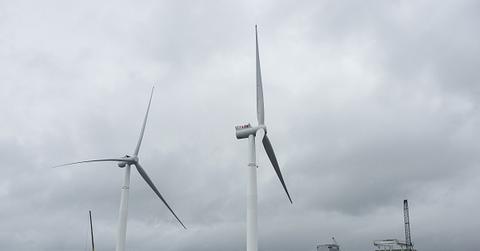World's First Floating Wind Turbine Sets Sail Off Coast Of Scotland
Statoil, which is the 11th largest oil and gas company in the world, is helping to develop a new version of offshore wind farms. These floating editions can reach deeper waters and have more capacity in each turbine, taking advantage of higher winds.
Updated May 26 2019, 3:43 p.m. ET
Asian communities are looking toward floating solar panels to increase renewable energy. With ongoing construction of offshore wind farms, it only seemed natural for the progression toward floating wind farms. Five of them are currently off the coast of Scotland and it will be able to power around 22,000 homes.
The Hywind project began as a prototype back in 2009. A single wind turbine was created by Statoil in Karmoy, Norway, on top of a floating spar buoy. Beginning in 2001, it spent eight years being a design, and eight years after that it has become the world’s first floating wind farm. The project has a capacity of 30 megawatts (six per turbine) and it will be 15 miles away from Peterhead in Scotland.
What is the benefit of having floating wind farms instead of the fixed offshore versions? It’s made to last in deeper waters far away from shore. They also can take advantage of the higher winds out in the ocean. It’s able to stay afloat because it weighs 46,000 metric tons (over 50,700 US tons) and it’s filled with over 8,000 liters of seawater, which equates to over 2,100 gallons.
One unique aspect of Statoil is they are not a renewable energy company. Instead, they are an oil and gas company developing ways that we can use less carbon-based fuels. Irene Rummelhoff, the executive vice president of the company, believes that floating wind farms open an “almost unlimited” opportunity in a report from The Guardian.
“Currently we are saying [floating windfarms will work in] water depths of between 100 and 700 metres, but I think we can go deeper than that...If you look at coastlines around the world, there’s few that have sufficient area at depths down to 40 metres so if they want to deploy offshore wind, they need to introduce floating wind.”
These Hywind turbines hold more capacity than traditional offshore wind turbines -- roughly 2.4 more megawatts. They’re taking advantage of wind speed that measures at 10 meters per second at the North Sea, or slightly over 22 miles per hour. It’s essentially a better version of the traditional offshore method, but there are some limitations.
As expected, costs are extremely high at the moment. This current Hywind project was only created thanks to subsidies received by the Scottish government. However, like other sustainable sources, these costs will come down in the future.
According to the report from The Guardian, Statoil believes that these floating wind farms will be the same cost as traditional versions by 2030. They still have plans for more construction and deployment for areas that don’t have shallow enough waters, and these could be the replacement for offshore wind farms when their lifecycle runs out.
